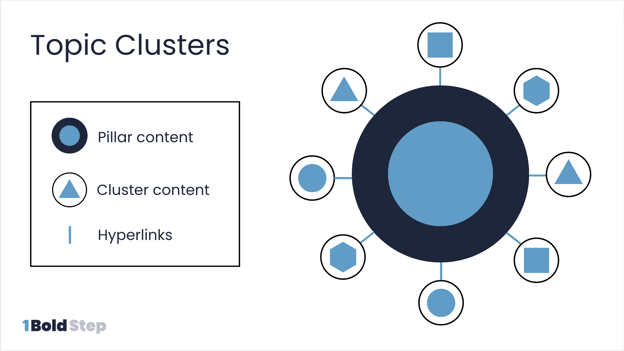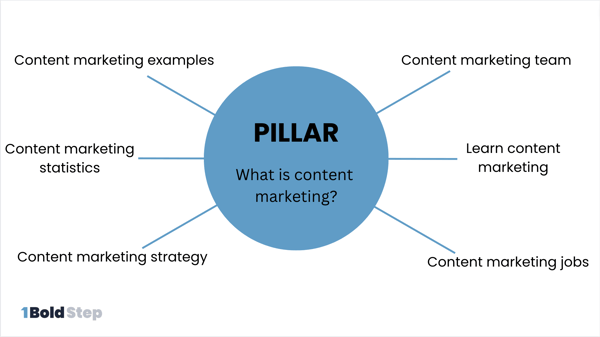If your organization has prioritized content creation in your marketing plan, great job! Relevant, high-quality content is key to winning over your audience and search engines alike.
But creating this content isn’t always easy. Between looking at keywords, researching topics, and actually taking the time to write the article (or having ChatGPT do it for you), it can be a time-consuming process. This is why it is essential to have a strategy behind your content creation.
Let’s discuss one of the most important content strategies for saving time and boosting SEO — topic clusters.
What are Topic Clusters?
A topic cluster is a strategic approach to organizing and linking related content on a website. Topic clusters are multiple pieces of content that are grouped together by a shared topic and subtopics. Visually, a topic cluster is built on a hub-and-spoke model that contains 3 main components: a pillar page, cluster content, and hyperlinks.

Let’s dive into each component.
Pillar Page
The pillar page covers the main aspects of the topic in-depth and provides links to more specific subtopics or related articles (known as “cluster content” which we’ll review next).
The pillar page acts as the center or the hub of the topic cluster, providing an authoritative source for your audience and search engines. If you do not currently have a page that can act as that authoritative page that you can link to your cluster content, then creating this page would be the first step for your topic cluster strategy. This content should contain at least 300 words of keyword-optimized content to give it the best chance of ranking in search engines.
Cluster Content
Once your pillar page has been identified and created, you are ready to start creating your cluster content.
Cluster content is typically in the form of several blog posts. If you have already been working on your content marketing strategy, then this portion will be very familiar. This is the part of the topic cluster strategy where you will write the relevant content you were (hopefully) already creating. Overall, it’s your goal to create a number of different blog posts all around the one overarching topic found on your pillar page. There is no minimum or maximum number of content pieces required, but starting off with 4-5 different pieces of content will be a great starting point.
Hyperlinks
The hyperlinks are where the topic cluster all comes together. To complete a topic cluster, you must link your cluster content back to your original pillar page, and vice versa. This gives your website visitors a path they can follow to find all of the relevant content they are looking for.
Say a website visitor enters your site through a blog they found through a search engine. Through your blog, you have given them relevant and helpful content. By linking your blog to your pillar page, you are now giving them a path to where they can find additional information. Ideally, your pillar page will not only give that extra information but also give the visitor a way to get more help if they need it, like through a lead or contact form.
By organizing your content this way, you are expanding the visibility of your cluster content and your pillar page. This benefits search engines by giving them a clear way to crawl the website and creating a convenient path for website visitors to learn more about specific topics. It’s an SEO win-win scenario!

Reasons why topic clusters are essential for SEO
Despite what you may have read, SEO is not dead. However, it has evolved. Many of the simple tips and tricks that we used to incorporate into our SEO strategy are not providing the quick wins we used to see. But creating high-quality, relevant content is still one the most important SEO strategies that need to be a part of every website. Here are some examples of what you can achieve with topic clusters and the reason they need to be part of your content marketing strategy.
Improved SEO
Improved SEO is one of the essential reasons topic clusters are critical to content marketing. By creating topic clusters, you are signaling to search engines and your audience that your website has authority on specific topics. It’s like being the one-stop shop for information — you are increasing trust and credibility with your blog readers, and establishing yourself as a thought leader. This authority could lead to what most content creators hope for: higher search engine rankings and increased traffic to your website.
Better User Experience
Topic clusters are a great way to improve the user experience for your blog readers. One of the most obvious reasons is that grouping your related content together makes it easier for users to find the information they are looking for.
However, that is not the only reason why topic clusters can help your website visitors. When you link your cluster content to a pillar page, you are giving users an easy way to find additional information on the topic they just read about, and in many cases, the area where they can explore your products and services designed around that topic. This can lead to increased engagement on your content and more time spent on your page, which are SEO signals that can lead to improved rankings.
Easier Content Creation
Once you’ve done all of the hard work of creating a pillar page and identifying your topic clusters, the actual content creation becomes easier and more efficient. By focusing on a central topic, you can brainstorm a range of subtopics that are related to that topic. This can give you great guidance into what you will write about next and allow you to dive deeper into topics that may be too complex for a single blog post.
The 5 Steps You Need to Get Started
Now that we have covered the different components of a topic cluster and why this strategy is important, where do you start? Here are the 5 steps that will help you go from planning to executing a perfect topic cluster.
1. Keyword Research
As is the case for most SEO strategies, this strategy will start with conducting keyword research. First, create a keyword list that includes relevant keywords to your products and services and find the opportunities within that list. There will be many metrics available, but the search volume and keyword difficulty will be the most important to review. The search volume will let you know if your topic is something your audience actually searches for, and the keyword difficulty will let you know how difficult it is to rank for those keywords.
2. Choose Your Topic
Once you have your list of keywords, the next step is to define your overarching topic for your topic cluster. The best way to do this is to take that keyword report you created in Step 1 and organize it by theme (this is usually your products or services). Once you have your keywords grouped together, you will need to ask yourself the following questions:
- Does it have enough search volume to justify the time put into it?
- Can I write many different pieces of content based on these keywords?
- Is this topic a core piece of my website?
To justify the time you are putting into a topic cluster, you will want your overarching topic to have a search volume of at least 500 searches per month. There’s no point in creating all of this content if no one is asking for it.
Your overarching theme will also need to have a few different subtopics that you can create content around, so your readers gain more information for each piece they spend time reading.
Lastly, your overarching topic should be something that your business provides. You are using this content to be the subject leader for this topic, it might as well be something you can use to bring in business.
3. Establish or Create a Pillar Page
Remember, the pillar page is the page on your site that acts as the main hub for the information you are creating. If this page already exists on your website, you can skip Step 4. If this page doesn’t currently exist, then it’s time to create one and optimize it around the keyword you chose for your overarching topic.
4. Internal Linking
The internal linking step may sound like it is the easiest, but it is the most crucial step that most people need to remember when planning their topic cluster.
This step involves utilizing the hyperlinks described above to create a path for your readers and search engines to follow. Simply put, this step is linking your cluster content to your pillar page.
The pillar page will in turn need to link back to the original piece of content. By doing this, you are creating a path for your readers to follow where they can find additional information about the topic they just read about, while you are telling the search engine what your page is about — making it easier to rank for those keywords.
5. Tracking
The last step of your topic cluster is to make sure it’s actually working. You will want to do this through tracking. The main metrics that should be tracked include blog/page views, clicks on links, and the time spent on the page. Some tools, like Hubspot, will actually create the hub-and-spoke model in their dashboard and track these relevant metrics for your cluster content and pillar page.
Wrapping Up
A good content marketing strategy should involve knowledge of a topic, keyword research, and content creation. If you are already taking these steps, content clusters are the perfect way to get the most out of the content you have already created and, hopefully, lead to better search rankings and more people visiting your site.





